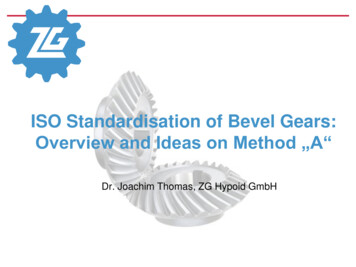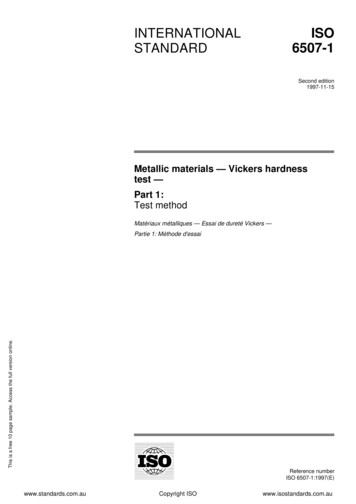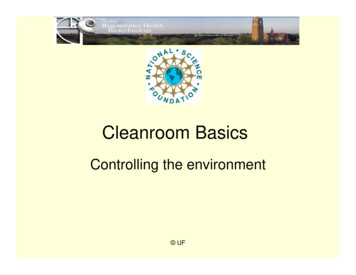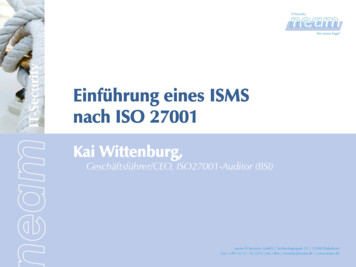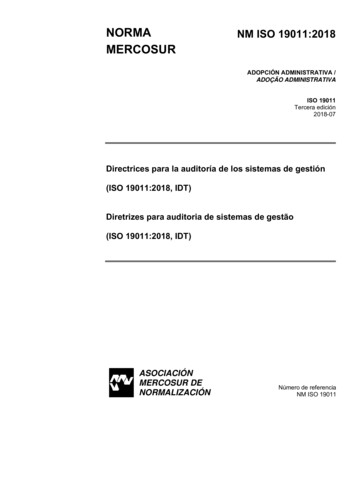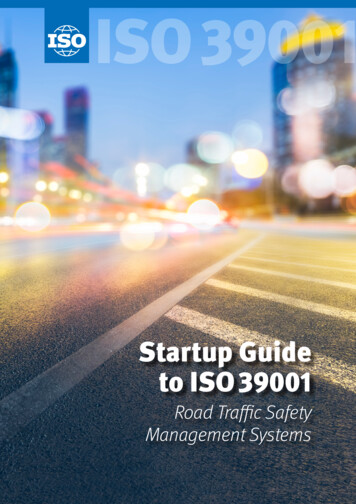
Transcription
ISO 39001Startup Guideto ISO 39001Road Traffic SafetyManagement Systems
STARTUP GUIDE TO ISO 39001: ROAD TRAFFIC SAFETYMANAGEMENT SYSTEMSPrepared by Martin Small and Jeanne BreenWhy adopt ISO 39001?ISO 39001 is the template for best practice road traffic safety management in an organizationalcontext. This document provides pointers for organizations wishing to use ISO 39001 to improvetheir road safety performance. The guide provides a brief introduction to what is involved indeveloping and implementing an ISO 39001 road traffic safety management system and encouragesfurther enquiry and consideration.-Preventing death and serious injury in road traffic crashes is a global priority Death and serious injury in road traffic crashes is a preventable problem imposing anunacceptably high burden on communities throughout the world. UN Sustainable Development Goals for road safety were agreed in 2015. Organizations can play a key role in improving road safety outcomes in low, middle andhigh-income countries.-Addressing a primary occupational safety risk -Successful road injury prevention requires management -Effective road safety management requires a systematic, results-focused approach.Organizations of all sizes can contribute to addressing global, regional and national goals,targets and objectives for road safety.ISO 39001 aligns with the best practice Safe System approach to road safety and the latestISO management system standard framework. Its best practice road safety focused contentis not found in management system standards on occupational health and safety.Adopting ISO 39001 will bring benefits including: -Road traffic injury is a leading cause of work-related death and serious injury.Continual improvement is needed to reduce and ultimately prevent road traffic deaths andserious injuries.ISO 39001 assists organizations in addressing road traffic injury risk, both on the networkand in the workplace.Preventing avoidable death and serious injury in the road traffic system, including theworkplace and while commuting.Contributing to better planning, design, operation and use of the road traffic system.Cutting organizational road crash and incident costs, reducing the number of workdays lostto injury and reducing insurance premiums and repair costs.Demonstrating social responsibility, improving organization profile and increasing business.ISO 39001 in practice ISO 39001 is being promoted globally by leading international organizations.ISO 39001 is being adopted across the world, including by small and medium enterprises.Organizations report a range of positive benefits from adopting ISO 39001.
Why do organizations need a road traffic safety management system?Preventing death and serious injury in road trafficcrashes is a global priorityRoad traffic injuries are the ninth leading cause of deathglobally, responsible for over 1.25 million deaths andtens of millions of people being injured or disabled everyyear (WHO, 2016). To accelerate action to reduce thisburden, the United Nations General Assembly declareda Decade of Action for Road Safety (2011–2020). UNSustainable Development Goals include road safetytargets to reduce deaths, achieve safe urban transport,and implement sustainable public procurementpractices. ISO 39001 addresses the contribution thatcan be made by organizations to prevent avoidabledeath and serious injury across the road traffic system.Road traffic injury is a leading cause of work-relateddeath and serious injuryInjuries in road traffic crashes contribute around 50% ofwork related deaths on public roads 1 2. These roadsafety outcomes are costly but preventable with goodpractice road safety management.Safety management systems are widely used by majorcorporations to limit organizational exposure to safetyrisks, and underpin safe aviation, maritime and railtransport operations. However, organizational management to improve road safety is less evident inroad traffic and in the mainstream of occupational health and safety programs, even in the mostactive countries in road safety.3A systematic, results-focused approach is neededRoad injury prevention requires a clear focus on achieving results, meaningful shared responsibilityand systematic management across public and private sectors. ISO 39001 assists organizations ofall types and sizes in the road safety management task.ISO 39001 is fully aligned with other ISO management system standards, including ISO 9001 QualityManagement Systems and ISO 14001 Environmental Management Systems. While ISO 39001provides direction on key safety issues and a strong focus on achieving better results for the interimand long-term, it does not prescribe specific safety measures. These are left for the organization todetermine through safety management processes.ISO 39001 is also fully aligned with the Safe System approach to road safety, which is embedded inthe UN Global Plan for Road Safety, and the UN Sustainable Development Goals. ISO 39001 isdesigned to help organizations reduce, and ultimately eliminate, the incidence and risk of death andserious injury related to road traffic crashes.The benefits of adopting ISO 39001Organizations that implement road safety management systems will be well placed to: Contribute to national and global efforts to prevent death and serious injury in road crashes.Demonstrate organizational commitment to an issue of significant public concern.Address one of the organization’s primary occupational safety risks.Cut organizational road crash and incident costs, and working days lost to injury.1 M Small, T Bailey and M Lydon, (2014) Work Related Road Safety RACV Research Report 14/01, Melbourne.23J Breen (2012, updated 2015) Work-Related Road Safety European Road Safety Observatory, Brussels.Royal Society for the Prevention of Accidents, (2012), Managing Occupational Road Risk, Birmingham,
Make the best use of available resources to target safety risks on the road.Promote the organization, improve its profile and increase business.Increase competitive advantage in tendering processes.Reduce insurance premiums and repair bills.The Safe System approachThe ultimate goal under the Safe System approach goal is to eliminate road fatalities and seriousinjuries, supported in the interim by periodic, quantitative targets to reduce deaths and seriousinjuries, as well as those factors that are causally linked to them.Safe System intervention addresses all elements of the road traffic system and their linkages - roadinfrastructure, vehicles, the emergency medical system, and road users. ISO 39001 provides amanagement tool to ensure the best possible results from these endeavors.Inspired by the reframing of road safety as a societal health issue in the best performing countries,the core of the ‘Safe System’ approach is the design and management of a road traffic system betterable to accommodate human error and recognize the physical vulnerabilities of road users. This isprimarily through managing crash energy, so that no individual road user is exposed to crash forceslikely to result in death or serious injury.ISO 39001 is a member of ISO’s family of management system standardsISO 39001 assists organizations in integrating road safety as acore objective into their management systems. As one of a familyof ISO management system standards, it is based on the latestcommon management standard framework developed by ISOand a Plan, Do, Check and Act process.The road safety management system can be integrated with thegeneral management system of an organization and with severalparallel disciplines of management system standards, e.g. ISO9001 (Quality) and ISO 14001 (Environment). Organizations thatalready hold certification to these will find it easier to establish aroad traffic safety specific component to their existingmanagement system, as well as offer added benefit from theunique elements provided by ISO 39001 that are not covered byany other ISO management system standard.Plan Do Act CheckThe road map to implementing ISO 39001In broad terms, an organization seeking certification to ISO 39001, or following this proven methodfor developing a safety management system before considering certification, would undertake thefollowing six steps of a basic plan-do-check-act model for continuous improvement.44 This section draws upon Annex A of ISO39001:2012 and guidance prepared in M Small, S Job, R Excell, C Sakashita, (2015) SafetyManagement Systems for Road Agencies: ISO 39001 and the Next Step Towards a Safe Road Transport System. Austroads ResearchReport AP-496-15, Sydney.
Step 1Scope &ContextStep 2Step 3Step 4LeadershipPlanningImplementationStep 5Step 6Monitoring &EvaluationContinualImprovement toElimination ofDeath andSerious InjuryStep 1: Scope and contextIdentify the impact the organization can have on road traffic safety (RTS), map that impact acrossinterested parties, and determine the organizational scope of an RTS management system (referclause 4 of ISO 39001).The standard requires the organization to commit to the long-term goal of the eventual eliminationof death and serious injury resulting from road traffic crashes, while allowing it to determine the scopeof the management system that it puts in place.The scope of the management system is best determined by first considering the following activitiesthat have an impact on road user safety: Employees' use of the road traffic system to and from work, or on duty.Goods and passenger transport in the road traffic system carried out by the organization, orcontracted to other organizations.Activities that generate traffic to and from locations controlled or influenced by theorganization such as supermarkets, schools, and locations with many visitors.Service delivery and products for the road traffic system, such as road or vehicle constructionor maintenance, as well as activities such as emergency trauma response or enforcement.Each of these activities can involve an organization in increasing the risk of fatality or serious injuryon the road network or on its premises, or reducing this risk. Interested parties need to be engagedduring this process, as they are likely to need to play a role in implementation.Step 2: LeadershipEstablish leadership commitment by adopting a long-term vision to eliminate death and seriousinjury and providing resources to establish, implement, maintain and continually improve the RTSmanagement system towards these ends. Establish, document and communicate RTS policy,and assign organizational responsibilities (refer clause 5 of ISO 39001).ISO 39001 requires top management of the organization to demonstrate leadership and commitmentin a variety of ways, including: Adopting the elimination of death and serious injury in road traffic crashes as the long-termRTS objective, as well as deciding on the RTS results to be achieved in the interim.Working in partnership and collaboration with interested parties to develop a safe road trafficsystem to achieve the established RTS objective(s).Communicating the importance of effective RTS management and conforming to the RTSmanagement system requirements.Nominating and allocating the human and financial resources to establish, implement,maintain and continually improve the RTS management system.Another key leadership aspect is the need to prepare a succinct policy statement that reflects thecommitment of top management to the elimination of death and serious injuries, and to continuous
improvement of the management system. The policy becomes a guiding document for developingobjectives and targets, and mobilizing the resources needed for their delivery.Step 3: PlanningDetermine risks and opportunities through assessment of current performance and identify theRTS performance factors that are relevant to the agency. Set objectives and targets for eachperformance factor and develop action plans (refer clause 6 of ISO 39001).A defining feature of ISO 39001 is the identification of safety performance factors that theorganization must consider when developing its objectives and targets. There are three sets of safetyperformance factors specified in the standard: Risk exposure factors (for example traffic volume on the road network by different usergroups, including vulnerable users – pedestrians, cyclists and motorcyclists).Final safety outcome factors (for example the number of deaths or serious injuries on theroad network).Intermediate safety outcome factors (those factors having an evidential base that links theirimprovement with improved safety).Intermediate safety outcomesWhile risk exposure factors and final safety outcome factors need to be continually monitored,intermediate safety outcome factors (which are causally linked to the final safety outcome factors)need the most attention. This is because they provide the best means of assessing the underlyinglevel of safety, rather than relying on relatively rare instances of crashes or injuries. Typicalintermediate outcomes or safety performance indicators that are targeted and/or monitored insuccessful road safety work include: Average mean speed or levels of excess speed.Levels of use of seat belts, child restraints and crash helmets.Levels of sober driving.Safety ratings of the road network using iRAP scores.Safety ratings of the vehicle fleet using NCAP ratings.Emergency medical system response times.Relevant institutional outputs can also be measured, targeted and monitored. An example is thelevel of fitment of seat belt reminders in the fleet that will affect levels of seat belt use.The general categories of RTS factors that need to be considered within ISO 39001 are: Road design and safe speed, especially considering separation (on-coming traffic andvulnerable road users), side areas and intersection design.Use of appropriate roads, depending on vehicle type, user, type of cargo and equipment.Use of personal safety equipment, especially cons
ISO management system standard framework. Its best practice road safety focused content is not found in management system standards on occupational health and safety. - Adopting ISO 39001 will bring benefits including: Preventing avoidable death and serious injury in the road traffic system, including the workplace and while commuting. Contributing to better planning, design, operation and use .




